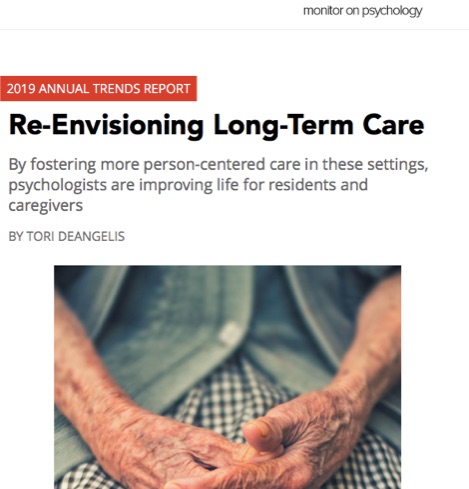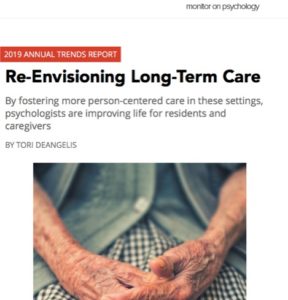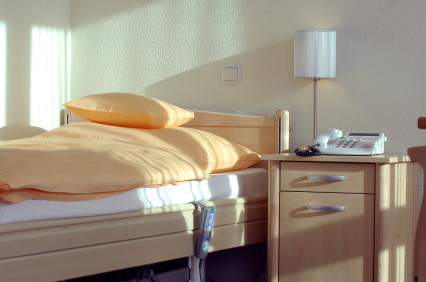Trend #5: Re-Envisioning Long-Term Care





Earlier this month, I took some much-needed time off to go on a cruise. I came home to a LinkedIn notification about “The big cost of not taking vacation,” reflecting on a CNN article regarding the vast number of vacation days forfeited by Americans. The author notes that people who travel tend to be happier with their jobs and companies than those who don’t.
It got me thinking (and researching) more about burnout and long-term care staffing problems. Certainly one piece of the puzzle is taking scheduled time off in order to refresh and gain perspective.
As I’ve noted in the past, there are many tactics employers can use to decrease burnout and turnover. In The keys to reducing turnover in LTC, I outlined the causes of the alarming rate of staff turnover in LTC, which can range from 55% to 75% for nurses and up to 100% for aides.
Preventing burnout in long-term care addressed training, staff scheduling and other adjustments that have been shown to reduce turnover. In another piece, I focused on ways to make long-term care jobs appealing enough to compete with less stressful jobs in the same salary range.
In my recent perusal of the research, I came upon a study that looked at factors contributing to the levels of anxiety experienced by staff members. The study suggested that the two biggest contributors to staff anxiety were “guilt about the care offered” because it wasn’t up to the standards of the individual workers and the “poor quality of the relationship with the residents’ family.”
Many of the suggestions I’ve offered in the articles noted above can improve the quality of care, but I was intrigued by the notion that improving relationships with residents’ families could have a significant impact on the anxiety levels of workers and thereby reduce burnout and turnover.



Feeling “down” takes on a wicked double-meaning for some seniors. Even conscientious providers could be unaware of it, let alone know what to do about it.
As McKnight’s Staff Writer Emily Mongan points out in “Depression treatments may increase risk of falls in SNF residents, study shows,” a psychosocial treatment for depression increased the likelihood of resident falls. I spoke with Suzanne Meeks, Ph.D., first author of the study, to discuss the problem and the results of her research.
Meeks and her colleagues studied the impact of the Behavioral Activities Intervention (BE-ACTIV) on depressed nursing home residents. They determined that the risk of falls in the treatment group was six times that of the control group, a statistically significant number.
Meeks told me all treatments for depression, including medication and behavioral interventions, increase the chance of falls. When an individual is no longer depressed, he or she has more energy to stand and walk, thus creating more opportunities to fall. If depression has immobilized them for some time, deconditioning may exacerbate the problem.
Meeks points out that more than 81% of her research subjects in both treatment and control groups were receiving antidepressants, suggesting that the behavioral intervention activated the residents more than the medication.
It’s important to treat people for depression despite the increased risk for falls because, as Meeks states, “depression is a fall risk.” Other researchers have found that the risk of falls increases when an individual has more of the following risk factors: depressive symptoms, antidepressant use, high physiological fall risk, and poorer executive function. Any two of these risk factors increase the likelihood of a fall by 55%. Participants with three or four risk factors were 155% more likely to fall — 155%!
The BE-ACTIV intervention
The BE-ACTIV model was quite successful in reducing depression, Meeks and her colleagues found, as described in an earlier article about their work. Study subjects in the 10-week treatment group were encouraged and assisted to participate in pleasant activities such as regularly scheduled group programs, in-room crafts and self-care such as haircuts. Compared to the “treatment as usual” control group, BE-ACTIV was “superior … in moving residents to full remission from depression.”



It can be challenging for long-term care providers when residents amass large quantities of possessions. Facilities generally worry about hoarding when the amount of belongings prohibits the resident or staff members from safely moving about their room or apartment.
Other concerns include fire safety and the possibility of attracting vermin in spaces that are unable to be properly cleaned, as well as apprehension that a cluttered room will attract negative attention from state surveyors.
On the other hand, cleaning out a room against the will of a resident could be perceived as a violation of their right to “security of possessions.”
Facilities often feel stuck between the proverbial rock and a hard place.
Firsthand observations
Over the years, I’ve observed many different scenarios that arise when facility try to manage residents’ hoarding. Here’s a small sample:
• “The State is going to be here any minute,” the Director of Social Work told me, her voice rising a couple of octaves with panic, “We need you to tell Mrs. White that she’s got to get rid of all that junk.”
• Hoarder Number One, complaining bitterly about Hoarder Number Two: “Why are they telling me I need to throw away my things when she has even more stuff than I do? Her room is a mess! At least mine is organized. They just don’t bother her because she’s friends with the administrator.” (All accurate perceptions.)
• Comment from the maintenance guys to the hoarding resident after showing up at the door with cardboard boxes and a dolly: “We’re going to pack up your room for a few weeks until after the State visits, then we’ll bring it back.”
• Sitting with Ms. Rosario following an unannounced purge of her room while she was at dialysis: “How could they do this to me? I trusted them! That stuff was really important to me,” she said, referring to, among other things, an assortment of straws and every food tray slip she’d gotten since her arrival at the facility over a year ago.
What is hoarding?



Poor sleep, reversed sleep/wake cycles, depression and falls are common problems in older adults. In addition, elders with dementia frequently experience late afternoon agitation, or “sundowning.” Because our residents live in a communal environment, a single individual’s agitation or late-night roaming can create a unit-wide problem for staff and other residents.
Research suggests there may be a solution that involves no medication or side effects. The answer could be the use of light.
According to Mariana Figueiro, Ph.D., professor and Light and Health program director at the Lighting Research Center at Rensselaer Polytechnic Institute, the results of the research on light are “very robust.” As she states in the January 2016 American Psychological Association Monitor, “I have no question that if you deliver the right light in Alzheimer’s patients, you improve their behavior; you will improve agitation; they will sleep better.”
Reduced ability to process light
Our bodies receive light via three different types of photoreceptors, the Monitor article explains, and it stimulates the brain in various ways to regulate sleep. As we age, the ability to process this light diminishes. In combination with age-related changes in the circadian rhythms that regulate sleep/wake cycles, reduced production of melatonin which aids slumber, and lifestyle adjustments such as decreased physical activity and exposure to outside light, this contributes to the sleep difficulties of older adults.
Some studies indicate that sleep disturbances have been associated with a buildup of beta-amyloid, a hallmark of Alzheimer’s disease. Researchers speculate that sleep helps to flush toxins such as beta-amyloid out of the brain. By improving the sleep quality of our residents, we therefore may be aiding them in many ways.
Light table
Theorizing that residents with dementia spend a great deal of time sitting around a table, Figueiro created a “light table” using an edge-lit LED television for the surface. This allows staff and residents to interact normally while receiving the appropriate amount of bluish white illumination. Her studies show a significant improvement in the quality of sleep of participants and a significant reduction in depression and agitation. Both of the latter held up fours weeks after the light source was removed.
See video above or click here: http://wnyt.com/article/stories/s3920645.shtml


Woohoo! My first column of 2016.
Which was started during a bout of insomnia in the last week of 2015.
What did I do when sleep failed me? What electronics-addicted individuals often do in the middle of the night. I grabbed my computer, caught up on email, and headed over to Facebook to find out what my Friends had been up to.
There I discovered a post about a company founded by two brothers called Life is Good, which emerged from the standing request the founders’ mother had for them as children in a chaotic home environment: Tell me something good about your day.
This helped the brothers become “glass half full” kind of guys, the type of people who donate 10% of their profits to help children overcome adverse childhood experiences.
And what does a T-shirt company have to do with long-term care? Well…
What if we started off this brand new year asking ourselves and our coworkers, employees and residents to tell us something good?
What if we put time and thought into focusing on the positive — into growing the good — and reminding ourselves why we’re all here working with elders?
I predict we’ll have more productive staff, better functioning teams, and happier residents.
It’s not just me doing the predicting. The Positive Psychology Center, led by director Martin Seligman, Ph.D., describes positive psychology as “the scientific study of the strengths that enable individuals and communities to thrive.”



Antipsychotic medications have proved ineffective at reducing the symptoms associated with dementia. They also have serious side effects in older adults, including restlessness, dizziness, higher likelihood of falls and other problems that can contribute to an increased risk of death.
Behavioral health interventions, on the other hand, have no such side effects and have been found effective in reducing behaviors such as aggression, care refusal and wandering.
Employing behavioral health techniques with people with dementia becomes increasingly valuable as facilities in this country endeavor to follow the Centers for Medicare & Medicaid Services guidelines and reduce the use of antipsychotic medications.
Global efforts
Dementia care is a pressing issue around the world, and other countries have made headway in shifting from medication to behavioral interventions. Psychologist Paula E. Hartman-Stein, Ph.D., of The Center for Healthy Aging, writes about international programs that implement behavioral health methods in the September/October edition of The National Psychologist.
Dr. Hartman-Stein spoke with Cameron Camp, Ph.D., an expert who consults with long-term care facilities in the United States and abroad.
France
Dr. Camp reports that the French government pays nursing homes to train their staff in non-pharmacological approaches to dementia. The training includes various strategies, including Montessori techniques such as those described by Dr. Camp in his excellent book, “Hiding the Stranger in the Mirror,” and other publications.
Australia
Camp notes that Alzheimer’s Australia provides funding to train staff in behavioral health approaches. Its website, Alzheimer’s Australia Information for Health Professionals, offers helpful information and brief videos that explain the techniques used.
Canada
In Canada, the Canadian Foundation for Healthcare Improvement reports on the success “beyond the team’s expectations” of an effort to reduce antipsychotic medications and implement non-pharmacological approaches. The project saved $400,000 in six months across the Winnipeg region.
STAR-VA in the USA
Here in the United States, the Veterans Health Administration, less constrained by the fee-for-service psychotherapy model that plagues the rest of the country, utilizes staff psychologists and other behavioral health professionals in their Staff Training in Assisted Living Residences (STAR-VA) model.



Though it was close to 20 years ago, I’ll never forget the reaction of one of my patients to losing both of her legs to diabetes.
“I’m 81 years old and I’ve traveled and danced as much as I could. I wasn’t sick a day in my life until this happened. I’m satisfied,” Lila told me earnestly.
I was astonished by her acceptance of such a difficult situation. If it had been me, I was sure I would have railed at the injustice of the world.
Residents like her, however, make it quite clear that it is possible to be grateful and to live fully, despite disability.
Lila came to mind recently when I asked a resident, Daisy, how she was doing three years after a debilitating stroke. Her curt reply: “The same old damn thing — I still can’t walk.”
Creating better mood
A 2015 study in Spirituality in Clinical Practice suggests it might be possible to use the tool of gratitude in order to help residents like Daisy.
The study looked at the impact of gratitude and spiritual well-being on a group of asymptomatic heart failure patients with an average age of 66.
The researchers found that “gratitude and spiritual well-being are related to better mood and sleep, less fatigue, and more self-efficacy.” Those positive effects can reduce the chances that an individual will move from being asymptomatic to symptomatic heart failure, which is “associated with a five-fold increase in mortality risk.”
The researchers point to studies that tried to enhance participants’ sense of gratitude. Gratitude is considered part of “positive psychology,” which focuses on the strengths that allow individuals and communities to thrive.



Standing by the salad bar in the newly opened restaurant, I recoiled at the sign that read, “Please don’t use your hands.” I suggested to the manager that the notice should instead advise diners to “Please use the serving spoons.” My recommendation for that short-lived establishment followed what’s known as “nudge principles.”
What are nudge principles?
Nudge principles use basic human tendencies to encourage people to engage in positive behavior. One aspect of nudge is to craft messages, like how to use the salad bar, in ways that are more likely to result in positive action.
Another aspect, according to Tori DeAngelis in Coaxing Better Behavior, is to harness “our less laudatory traits — short-sightedness, inertia, inflated optimism and our tendency to submit to peer pressure.”
Research shows people have a “default bias” which makes them more likely to choose the first option in front of them. Putting fresh fruit before the desserts in a cafeteria line would be one way of making positive use of this bias. Another is creating a default option that enrolls employees in a retirement account rather than requiring them to opt into the program.
Care must be taken to create good default options, though, or they can backfire. One poorly constructed automatic retirement account enrollment, for instance, resulted in more individuals contributing, but fewer dollars set aside overall. Why? The default choice set aside less money than what people might have chosen if they’d given it more thought.
Starting with the end result
Some “nudge” researchers identify the outcome they want to see and then look at what methods are most successful in achieving that outcome. In one study, the British government sent letters to delinquent taxpayers, saying, for example, “You are one of the few who have not paid us yet.” They altered the wording of the letters to see which phrasing would result in the greatest collection of outstanding funds — and retrieved an extra $15 million overall.
Applying nudge principles in LTC



In my recent post, “Stuff I won’t do for residents and why your staff shouldn’t either,” I wrote about the need for individual workers to set appropriate boundaries around caregiving in order to retain the ability to give without burning out. In this article, I examine more closely the symptoms of burnout and ways facilities can reduce its likelihood — which is particularly important given the link between burnout and turnover.
Employers find burnout reflected in high levels of absenteeism and tardiness, extended sick leave, and an increase in worker’s compensation claims. Employees might notice symptoms such as stress-related medical conditions (for example, ulcers or headaches), reduced job satisfaction, feelings of depression, anxiety, cynicism, boredom, discouragement and loss of compassion.
One study found that burned out staff were more likely to be accepting of resident abuse (Shinan-Altman and Cohen, 2009).
What is burnout?
In my research, I came across a number of definitions of burnout. Some definitions, like this early description by psychologist Herbert Freudenberger, focus on the role of the individual:
Burnout is “a state of fatigue or frustration brought about by devotion to a cause, way of life, or relationship that has failed to produce the expected reward.” People most likely to burn out are those who are the most “dedicated and committed to their positions, have poor work boundaries and who have an over excessive need to give.”
Ouch.
Other explanations of burnout focus on the environment, such as this one by Pines and Aronson (1988): Burnout is “a state of physical, emotional, and mental exhaustion caused by long-term involvement in emotionally demanding situations.”
It’s probable that most burnout is due to a combination of a stressful work environment and an individual’s difficulty balancing self-care with their commitment to their jobs.
Techniques to reduce burnout
The good news for management is that many of the causes of burnout can be addressed by the organization, whether they are due to the environment or rooted in the individual.
1. Training workers, including enhancing the initial orientation process and providing ongoing education programs that go beyond mandated courses, can address many factors that contribute to burnout. Studies suggest the following:
Orientation classes should provide clear job expectations and address ways to prioritize job tasks in order to reduce time pressures.
Managerial staff such as nurses and department heads would benefit from skills training to better help them supervise and manage their teams.
Team building efforts can improve relationships with coworkers and reduce professional isolation.
Training staff on how to manage aggressive behaviors reduces the stress of working with a verbally and physically aggressive population.
2. Scheduling issues are another area where management can make a significant impact on burnout through:
